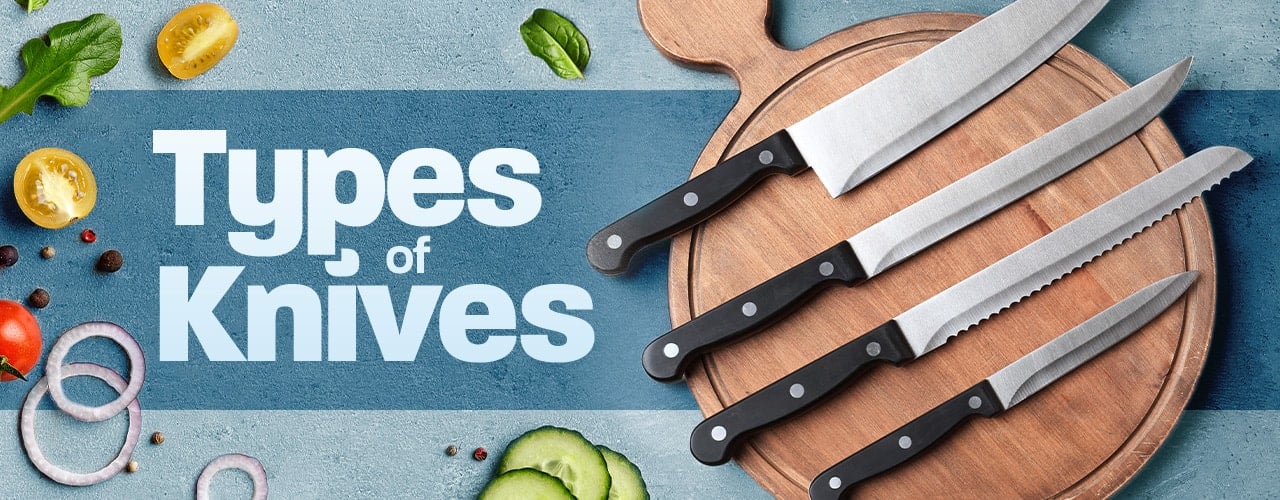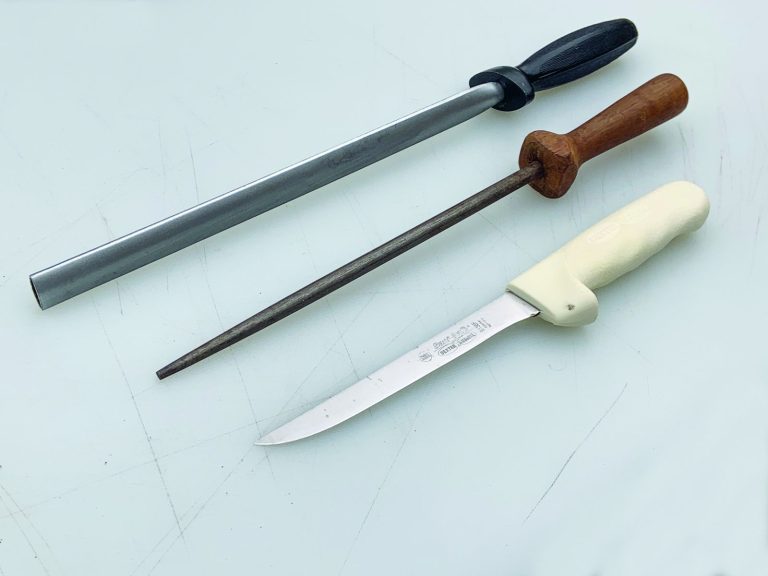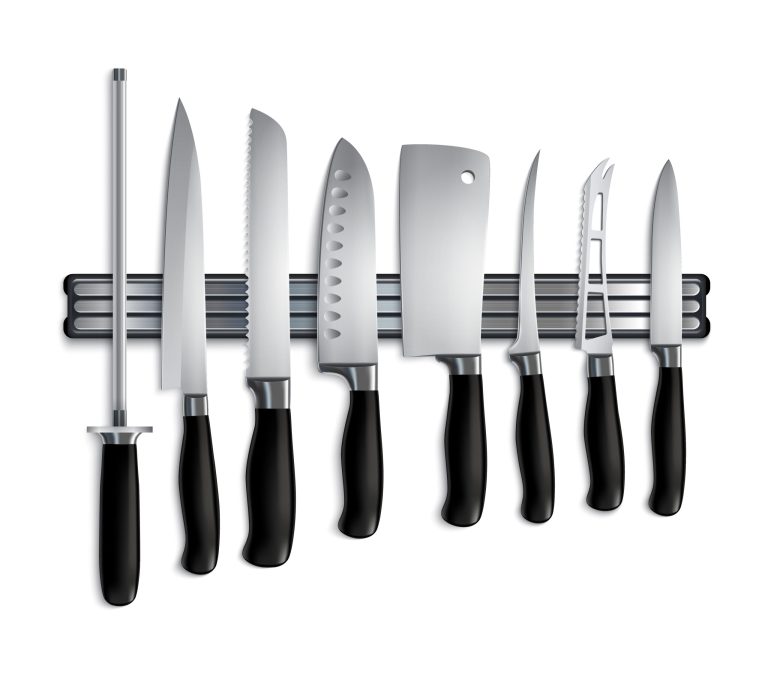Different Types of Chef Knives
Chef knives come in various types that serve different purposes in the kitchen. We will explore the different types of chef knives, including their unique features and uses, to help you choose the right one for your culinary needs.
A chef knife is an essential tool for any chef or home cook. With the right knife, you can achieve precision and efficiency in your cutting tasks. However, with so many options available, it can be overwhelming to choose the right chef knife for your needs.
That’s where knowing the different types of chef knives can be helpful. Each type of chef knife is designed for specific tasks, such as slicing, dicing, chopping, or delicate tasks like filleting fish. By understanding the features and uses of each type, you can select the perfect chef knife to enhance your culinary skills and make your cooking experience a joy.
Understanding The Basic Knife Types
| Type | Description |
|---|---|
| Chef’s Knife | A versatile and multipurpose knife designed for various tasks, such as chopping, slicing, and dicing. It has a wide, curved blade and a pointed tip, allowing for efficient rocking motions while cutting. |
| Santoku Knife | A Japanese knife with a shorter and wider blade, ideal for precise slicing, dicing, and mincing. It features a straight edge, granting cleaner cuts and reducing food sticking to the blade. |
| Paring Knife | A small knife with a narrow, pointed blade commonly used for intricate tasks like peeling, trimming, and shaping. It provides enhanced control and precision for delicate work. |
Chef knives form an essential part of any culinary journey. They come in various types, each serving a specific purpose. The chef’s knife is a versatile tool, perfect for chopping, slicing, and dicing thanks to its wide, curved blade and pointed tip. On the other hand, the santoku knife, originating from Japan, provides precise cuts with its shorter, wider blade and straight edge. Lastly, the paring knife comes in handy for delicate tasks like peeling, trimming, and shaping due to its narrow, pointed blade.
Specialized Knives For Specific Tasks
Chef knives come in various types, each designed for specific tasks. One such specialized knife is the Bread Knife. This serrated knife is perfect for slicing through crusty bread without squishing it. The sharp teeth on the blade make it easy to create clean, even slices.
Another important type of knife is the Boning Knife, which is essential when working with poultry, meat, or fish. Its narrow and sharp blade allows for precise deboning and trimming. The flexibility of the blade makes it easier to navigate around bones and joints.
When it comes to delicate tasks like filleting fish, a Fillet Knife is a must-have. The thin, flexible blade of a fillet knife allows for precise movements and ensures the removal of bones and skin while retaining as much meat as possible.
Different Knife Handles And Materials
A chef knife is a crucial tool in any kitchen, and there are various types to choose from. When it comes to different knife handles, there are several options available to cater to personal preferences and cooking needs. One popular choice is wood handles, which offer a traditional and elegant look. Wood handles provide a comfortable grip, making it easier to control the knife while cutting. Plastic handles are another option, offering durability and affordability. These handles are lightweight and easy to clean, ideal for everyday use in a busy kitchen.
On the other hand, stainless steel handles are known for their sleek and modern appearance. They provide excellent balance and stability, making them popular among professional chefs. Additionally, stainless steel handles are resistant to corrosion and can withstand high temperatures. Overall, the choice of knife handle material depends on individual preferences, comfort, and the desired aesthetic for your kitchen.

Credit: www.webstaurantstore.com
Exploring Blade Materials And Construction
When it comes to chef knives, the type of blade material and construction is crucial. Let’s explore the different types of chef knives available.
Carbon Steel Blades
Carbon steel blades are known for their sharpness and durability. They are made from a combination of iron and carbon, which gives them their exceptional cutting edge. However, they require regular maintenance as they are prone to rusting.
Stainless Steel Blades
Stainless steel blades are popular due to their resistance to corrosion. They are highly durable and do not require much maintenance. However, they can be more challenging to sharpen compared to carbon steel blades.
Damascus Steel Blades
Damascus steel blades are renowned for their beautiful and unique patterns. They are made by layering different types of steel together, resulting in a strong and sharp blade. Damascus steel blades offer excellent cutting performance but tend to be more expensive compared to other types.
Blade Shapes And Their Uses
Different types of chef knives come with a variety of blade shapes to serve specific purposes. Understanding the blade shapes and their uses can help you make the right choice for different culinary tasks.
Straight Blade: A straight blade is the most common and versatile type of chef knife. It features a sharp, straight edge that makes it ideal for slicing, dicing, and chopping various ingredients with precision. The straight blade allows for even, controlled cuts, making it a favorite among professional chefs.
Serrated Blade: A serrated blade, also known as a bread knife, has a saw-like edge with serrations or ridges. This blade shape is perfect for cutting through foods with tough exteriors, such as bread, tomatoes, or citrus fruits. The serrations grip the surface, preventing the blade from slipping, resulting in clean, effortless cuts.
Granton Edge Blade: A Granton edge blade features hollowed-out oval-shaped depressions along the edge. This design creates air pockets that reduce friction and minimize food sticking to the blade. The Granton edge is commonly found on slicing and carving knives, allowing for thin, smooth slices of meats and roasts.
Knife Maintenance And Sharpening Techniques
A chef knife is an essential tool in every kitchen, but it’s important to know how to properly care for and sharpen it to maintain its effectiveness. Honing and sharpening are two techniques that can help keep your knife in top shape. |
Honing: Honing is the process of realigning the blade’s edge and should be done regularly to maintain the knife’s sharpness. Using a honing rod, you can carefully run the blade along the rod to straighten any microscopic bends or misalignments. |
Sharpening: Sharpening, on the other hand, involves removing material from the blade to create a new, sharp edge. This is done using sharpening tools such as whetstones or electric sharpeners. |
Proper knife care is also crucial for maintaining the longevity of your chef knife. It’s essential to clean and dry the knife after each use, as well as store it in a suitable knife block or sheath. Avoid cutting on hard surfaces, such as glass or metal, as they can dull the blade. |
When it comes to sharpening your knife, there are various tools and methods to choose from. Whetstones offer precision and control, while electric sharpeners provide convenience. It’s important to choose the method that works best for you and matches the level of sharpening skill you possess. |
Considering Price Range And Quality
The different types of chef knives available in the market can vary greatly in terms of price range and quality. When considering budget chef knives, there are options available which are affordable without compromising on quality. These knives are suitable for home cooks and those who are just starting their culinary journey. Moving up to mid-range chef knives, you can expect a higher level of craftsmanship and durability. These knives are often used by professional chefs and provide a good balance between quality and price. For those who are looking for the best of the best, high-end chef knives are the way to go. These knives are meticulously crafted using top-quality materials and offer exceptional performance and longevity.
Ergonomics And Comfort In Knife Design
Ergonomics and comfort are vital considerations when it comes to chef knives. The weight and balance of the knife play a crucial role in ensuring a comfortable and efficient cutting experience. A well-balanced knife allows for better control and reduces strain on the hand and wrist, minimizing fatigue during prolonged use.
Handle design also contributes to the overall ergonomics of a knife. The handle should be comfortable to hold, providing a secure grip and reducing the risk of slippage. Some handles incorporate ergonomic shapes and materials that enhance comfort and reduce strain.
Another aspect of knife design related to ergonomics is the finger guard. A finger guard is a protective feature located between the blade and the handle. It prevents the fingers from accidentally slipping forward onto the sharp edge while ensuring a firm grip on the handle. A well-designed finger guard enhances safety and confidence while using the knife.
Finding The Right Chef Knife For Your Needs
When it comes to selecting the right chef knife, it is important to consider your cooking style and cutting techniques. Identifying your cooking style can help determine the type of knife that would best suit your needs. Assessing your cutting techniques allows you to understand the kind of knife that would provide you with optimal control and precision.
Trying different knives in person is a great way to find the perfect fit. Visit a store where you can hold and test different knives to see which one feels comfortable in your hand. Pay attention to the weight, balance, and grip of the knife.
Conclusion
Understanding the different types of chef knives is essential for any professional or aspiring chef. Each knife serves a specific purpose and can greatly enhance the efficiency and precision of food preparation. From the versatile chef’s knife to the delicate boning knife, each tool has its own unique characteristics that contribute to the culinary process.
Investing in high-quality chef knives not only ensures superior performance but also safety in the kitchen. Being aware of the various types of chef knives allows chefs and home cooks to select the right tool for specific tasks, resulting in better outcomes and improved overall cooking experience.
By knowing the strengths and weaknesses of different knives, chefs can unleash their full culinary potential and create culinary masterpieces. So, whether you are slicing, dicing, or filleting, choosing the appropriate chef knife will undoubtedly elevate your cooking skills to new heights.






